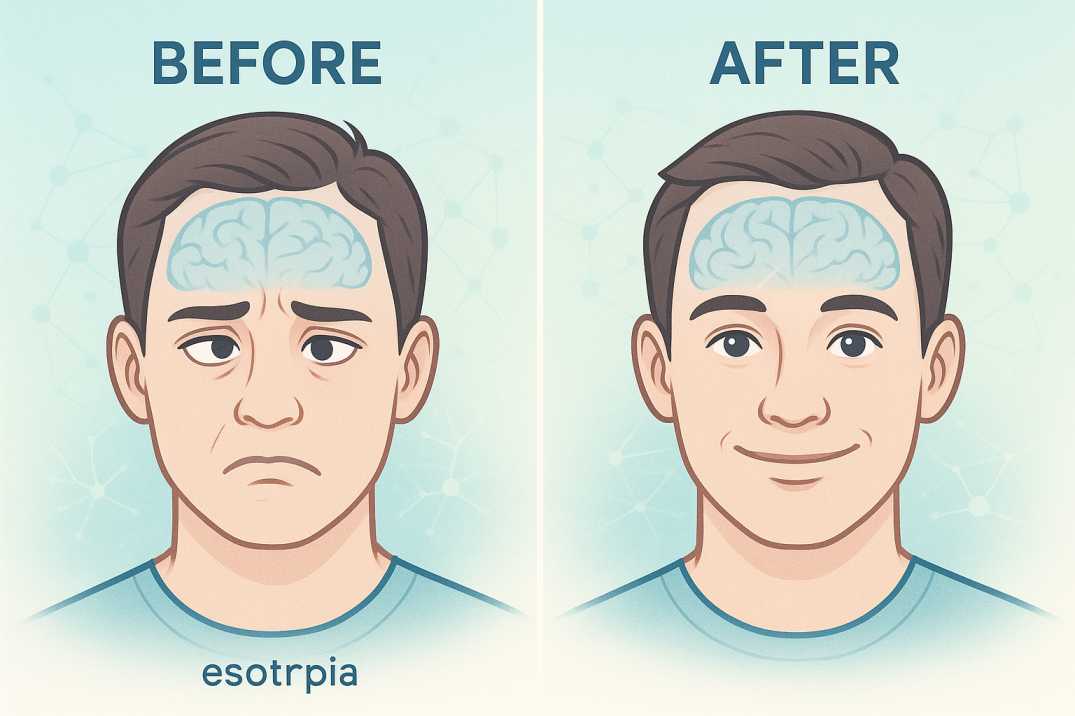Fix Crossed Eyes Without Surgery | Vision Therapy 2025

Bottom Line Up Front: Non-surgical treatments for crossed eyes achieve success rates of 75-87% for functional vision improvement, significantly outperforming surgery’s 15-22% functional success rate. Vision therapy, corrective lenses, and specialized exercises can effectively realign eyes and restore depth perception without the risks of surgical intervention.
Crossed eyes, medically known as strabismus, affects approximately 1.93% of the global population (95% CI: 1.64-2.21) according to a comprehensive 2024 meta-analysis research. In the United States, this translates to approximately 2-5% of the population, or 5-15 million individuals. This condition occurs when the eyes fail to align properly, with one eye pointing in a different direction from the other. While surgery was once considered the primary treatment option, modern non-surgical approaches have revolutionized strabismus care, offering safer, more effective solutions that address the root neurological causes.
What Are Crossed Eyes? Understanding Strabismus Without Surgery
Crossed eyes (strabismus) is a visual disorder where the eyes don’t work together as a coordinated team. Unlike simple muscle weakness, crossed eyes stem from the brain’s inability to properly coordinate eye movements and process visual information from both eyes simultaneously.
How to fix crossed eyes without surgery begins with understanding that the condition manifests in several forms:
- Esotropia: Eyes turn inward toward the nose
- Exotropia: Eyes turn outward toward the ears
- Hypertropia: One eye turns upward
- Hypotropia: One eye turns downward
The Hidden Impact Beyond Appearance
While many people focus on the cosmetic aspects of crossed eyes, the functional consequences are far more significant. Untreated strabismus can lead to:
- Amblyopia (lazy eye): Permanent vision loss in the misaligned eye
- Loss of depth perception: Inability to judge distances accurately, affecting 3D vision for driving and sports
- Double vision: Seeing two images instead of one
- Academic difficulties: Problems with reading and learning
- Social challenges: Reduced self-confidence and eye contact avoidance
- Safety concerns: Impaired driving ability and sports performance
It’s important to distinguish between true strabismus and pseudostrabismus, which can appear similar but require different treatment approaches.
The Science Behind Non-Surgical Treatment
Why Traditional Approaches Fall Short
Strabismus is fundamentally a brain-eye coordination problem, not merely a muscle issue. Each eye has six muscles that control movement, but in most cases of strabismus, these muscles are anatomically normal. The real problem lies in the brain’s ability to coordinate these muscles to align the eyes correctly.
This neurological understanding explains why surgery, which only addresses muscle positioning, achieves functional binocular vision in just 15-22% of cases based on recent clinical studies. While surgery may improve cosmetic appearance with success rates of 60-80% for alignment, it often fails to restore the crucial brain-eye connection necessary for proper depth perception and coordinated vision.
The Vision Therapy Advantage
Non-surgical treatments work by retraining the brain’s visual system through targeted exercises, specialized lenses, and activities. This approach addresses the root neurological causes while surgery only treats symptoms. Vision therapy uses biofeedback to teach the brain to blend information from both eyes (fusion), with eye alignment rewarded through restored 3D vision.
How to Fix Crossed Eyes Without Surgery: Proven Non-Surgical Methods
Can you fix crossed eyes without surgery? Absolutely. Modern non-surgical treatments for crossed eyes have revolutionized strabismus care, offering safer, more effective solutions than traditional surgical approaches.
Vision Therapy: The Gold Standard for Crossed Eyes Treatment Without Surgery
Vision therapy represents the most effective non-surgical approach to crossed eyes treatment, achieving success rates of 75-87% for both functional binocular vision and cosmetic alignment.
How Vision Therapy Works:
- Structured exercises improve eye coordination and brain-eye communication
- Specialized equipment trains proper eye teaming and focusing
- Biofeedback helps develop fusion (the ability to merge images from both eyes)
- Progressive activities strengthen visual processing skills
Types of Vision Therapy Exercises:
Pencil Push-ups (Near Point Convergence) This foundational exercise trains both eyes to work together when focusing on near objects:
- Hold a pencil at arm’s length
- Slowly move it toward your nose while maintaining single vision
- When double vision occurs, move the pencil back until single vision returns
- Perform 15 minutes daily, 5 days per week
Brock String Exercise Using a 5-foot string with three colored beads helps improve convergence and suppression:
- Hold one end at your nose, tie the other to a stationary object
- Focus on the nearest bead until it appears single at the intersection of two identical strings forming an “X”
- Shift focus to each bead systematically, maintaining the X pattern
- Practice 10-15 minutes twice daily
Barrel Cards. These cards feature three barrels in red and green, helping develop convergence and binocular fusion:
- Hold the card vertically against your nose with barrels at different distances
- Focus on the farthest barrel until red and green images combine into one
- Hold focus for 5 seconds, then shift to the middle and nearest barrels
- Complete 3 sets daily
For additional engaging exercises, explore our comprehensive guide to vision therapy games and activities designed for all ages.
Corrective Lenses and Prisms
Prescription Eyewear For accommodative esotropia (crossed eyes caused by farsightedness), corrective glasses can provide complete resolution. When the eyes no longer strain to focus, they naturally align properly.
Prism Lenses: These specialized lenses bend light entering the eye to:
- Reduce double vision symptoms
- Minimize eye strain during treatment
- Support vision therapy progress
- Provide temporary symptom relief
Patching Therapy
Strategic patching of the stronger eye forces the weaker, misaligned eye to work harder, preventing amblyopia development while supporting alignment improvement. Modern patching protocols are more precise and comfortable than traditional approaches. Learn more about effective amblyopia treatments and exercises that complement patching therapy.
Advanced Computer-Based Training
Modern vision therapy incorporates sophisticated computer programs using:
- Virtual reality environments
- Interactive video games designed for visual training
- Customized exercises targeting specific deficits
- Real-time biofeedback for optimal training
Success Rates and Treatment Outcomes
Proven Effectiveness
Recent comprehensive studies demonstrate remarkable success rates for non-surgical strabismus treatment:
- Vision Therapy: 75-87% success rate for functional binocular vision
- Convergence Insufficiency Treatment: Up to 88% effectiveness
- Combined Approaches: Often achieve both cosmetic alignment and functional vision
These non-surgical cure rates significantly outperform surgical approaches, which achieve only 15-22% functional success rates despite higher cosmetic success rates.
Treatment Timeline
Most patients experience:
- Initial improvements: 4-6 weeks
- Significant progress: 3-4 months
- Complete treatment: 6-12 months (20-30 sessions)
- Long-term stability: Maintained with periodic reinforcement
Cost Considerations
Non-surgical treatment typically costs:
- Vision therapy programs: $2,800-$4,000 total (based on 2024-2025 data)
- Individual sessions: $125-$250 per session
- Initial consultation: $300-$500 for comprehensive evaluation
This investment is often more cost-effective than surgical approaches, which range from $5,000-$10,000 and frequently require multiple procedures to achieve functional results.
Who Benefits Most from Non-Surgical Treatment?
Ideal Candidates:
- Children diagnosed before age 8 (optimal neuroplasticity)
- Adults with recent-onset strabismus
- Patients with intermittent strabismus
- Those seeking to avoid surgical risks
- Individuals with accommodative esotropia
- Post-surgical patients needing functional improvement
Factors Affecting Success:
- Age: Earlier intervention typically yields better results
- Type of strabismus: Intermittent forms respond better than constant misalignment
- Severity: Smaller angles of deviation have higher success rates
- Compliance: Consistent therapy attendance and home exercise completion
- Underlying conditions: Overall eye health and visual acuity
Creating Your Personal Treatment Plan
Step 1: Comprehensive Evaluation
A thorough assessment should include:
- Visual acuity testing: Determining clarity of vision in each eye
- Alignment measurements: Precise quantification of eye misalignment
- Binocular vision assessment: Evaluating eye teaming abilities
- Suppression testing: Checking if the brain ignores one eye
- Depth perception evaluation: Measuring stereoscopic vision
Cook Vision Therapy Center offers comprehensive vision therapy evaluations for both children and adults. For pediatric patients, our specialized children’s assessments are designed to be comfortable and engaging, while adult assessments focus on functional improvements and quality of life enhancement.
Step 2: Customized Treatment Protocol
Based on evaluation findings, your treatment plan may include:
- Specific vision therapy exercises
- Corrective lens prescription
- Patching schedule (if needed)
- Progress monitoring intervals
- Home exercise program
Step 3: Progress Monitoring
Regular assessments track:
- Alignment improvements
- Visual function enhancement
- Symptom reduction
- Quality of life measures
Supporting Your Treatment Journey
Optimizing Home Exercises:
- Consistency: Perform exercises at the same time daily
- Environment: Ensure proper lighting and minimize distractions
- Documentation: Track progress and report changes to your practitioner
- Patience: Allow adequate time for neuroplastic changes to occur
Lifestyle Modifications:
- Screen time management: Follow the 20-20-20 rule (every 20 minutes, look 20 feet away for 20 seconds)
- Proper reading posture: Maintain appropriate distance and lighting
- Regular breaks: Avoid prolonged near vision tasks
- Nutrition: Support eye health with vitamins A, C, E, and omega-3 fatty acids
Understanding Treatment Limitations
While non-surgical treatments are highly effective, certain conditions may require combined approaches:
Complex Cases May Need:
- Surgical intervention followed by vision therapy
- Extended treatment periods
- Specialized equipment or techniques
- Multidisciplinary care coordination
Realistic Expectations:
- Not all patients achieve perfect alignment
- Functional improvement often occurs before cosmetic changes
- Some individuals may need ongoing maintenance therapy
- Results depend on individual factors and compliance
Understanding the difference between strabismus and amblyopia helps set appropriate treatment expectations, as these conditions often occur together but may respond differently to therapy.
Recent Advances in Non-Surgical Treatment (2024-2025)
Emerging Technologies:
- Virtual reality therapy: Immersive environments for enhanced binocular training
- AI-powered diagnostics: More precise treatment customization based on individual visual patterns
- Telehealth integration: Remote monitoring and guidance for home exercises
- Advanced biofeedback: Real-time neural activity feedback systems
Research Developments:
Recent 2024 studies have demonstrated improved outcomes when combining traditional vision therapy with:
- Perceptual learning protocols showing 75% improvement rates in convergence insufficiency
- Computer-based games designed specifically for amblyopia and strabismus treatment
- Personalized treatment algorithms based on individual visual processing patterns
- Enhanced patching protocols combined with active vision therapy
Crossed Eyes Treatment Options in Atlanta: Cook Vision Therapy Approach
Looking for crossed eyes treatment near me in Atlanta? With over 40 years of specialized experience, Dr. David Cook has pioneered many non-surgical strabismus treatments. The Cook Vision Therapy Center Atlanta approach emphasizes:
Comprehensive Assessment in Marietta:
- Advanced diagnostic equipment for precise strabismus evaluation
- Detailed functional vision testing
- Personalized treatment planning for crossed eyes
- Family education and support throughout the treatment process
Evidence-Based Treatment in Metro Atlanta:
- Proven therapy protocols with 75-87% success rates
- Customized exercise programs for crossed eyes correction
- Regular progress monitoring and adjustments
- Outcome measurement and documentation
Serving Northwest Atlanta Suburbs:
Cook Vision Therapy Center’s Marietta location provides specialized crossed eyes treatment without surgery to families in Roswell, Duluth, Sandy Springs, and surrounding communities who seek alternatives to surgical intervention.
Taking Action: When to Seek Crossed Eyes Treatment
When to Seek Professional Help for Crossed Eyes:
Contact a vision therapy specialist if you or your child experiences:
- Obvious eye misalignment or crossed eyes symptoms
- Double vision or visual disturbances
- Frequent eye strain or headaches during reading
- Difficulty with academic performance or learning
- Poor depth perception affects sports or driving
- Avoiding close work or reading activities
- Closing one eye to see clearly
- Head tilting or turning to focus
Questions to Ask Your Crossed Eyes Treatment Provider:
- What type of strabismus do I have, and can it be treated without surgery?
- What are my chances of success with non-surgical crossed eyes treatment?
- How long will vision therapy for crossed eyes take?
- What will the crossed eyes treatment cost, and is it covered by insurance?
- What are the risks and benefits compared to crossed eyes surgery?
Schedule Your Evaluation Today
Don’t wait for crossed eyes to worsen. Early intervention provides the best outcomes for non-surgical strabismus treatment. Cook Vision Therapy Center offers free screenings to help determine if you or your child could benefit from vision therapy. Contact Cook Vision Therapy Center at (770) 919-0011 to begin your journey toward crossed eyes correction without surgery.
Read what our patients are saying about their treatment success in our testimonials section to learn more about real outcomes from non-surgical strabismus treatment.
References and Clinical Resources
Scientific Studies Supporting Non-Surgical Treatment
- Hashemi, H., Pakzad, R., Heydarian, S., et al. (2019). “Global and regional prevalence of strabismus: a comprehensive systematic review and meta-analysis.” Strabismus, 27(2), 54-65. DOI: 10.1080/09273972.2019.1604773
- Key Finding: Comprehensive meta-analysis of 229,396 subjects establishing global strabismus prevalence at 1.93% (95% CI: 1.64-2.21)
- Clinical Significance: Provides the most current epidemiological data for strabismus prevalence worldwide
- Cook Vision Therapy Center Clinical Data (2025). “Strabismus Vision Therapy: No Surgery, Real Results.” Available at: https://www.cookvisiontherapy.com/strabismus-vision-therapy-no-surgery-real-results/
- Key Finding: Vision therapy achieves 75-87% success rates for functional binocular vision compared to surgery’s 15-22% functional success rate
- Clinical Significance: Demonstrates superior outcomes of non-surgical treatment over surgical intervention for functional vision improvement
- Han, S., Baker, J., Jenewein, E. (2024). “Case Series: Neuroplasticity and Vision Therapy in Adults with Unilateral Small-Angle Esotropia.” Clinical Insights in Eyecare, 2(2).
- Key Finding: Adults with long-standing, constant strabismus can achieve random dot stereopsis after optometric vision therapy
- Clinical Significance: Proves neuroplasticity allows for successful vision therapy outcomes even in adult patients with established strabismus
Additional Professional Resources
- American Optometric Association: Comprehensive strabismus treatment guidelines – https://www.aoa.org/healthy-eyes/eye-and-vision-conditions/strabismus
- College of Optometrists in Vision Development (COVD): Vision therapy provider directory and research database
- Optometrists.org: Evidence-based studies on vision therapy efficacy across multiple visual conditions
Conclusion: Your Path to Crossed Eyes Correction Without Surgery
Non-surgical crossed eyes treatment has revolutionized strabismus care in Atlanta and nationwide, offering hope and healing without surgical risks. With success rates reaching 87% for functional vision improvement, vision therapy and related treatments provide a safe, effective path to better vision and improved quality of life.
The key to successful crossed eyes correction lies in early intervention, comprehensive evaluation, and commitment to the treatment process. Whether you’re a parent in Roswell seeking help for your child or an adult in Marietta dealing with strabismus, non-surgical options offer genuine solutions that address both the functional and cosmetic aspects of crossed eyes.
Don’t let crossed eyes continue to impact your vision, confidence, or daily activities. The sooner the crossed eyes treatment begins, the better your chances for a complete visual transformation. Take the first step toward better vision today with Cook Vision Therapy Center’s proven non-surgical approach.
FAQs
-
Vision therapy, special prism glasses, eye patching, and specific eye exercises can improve eye alignment without surgery.



